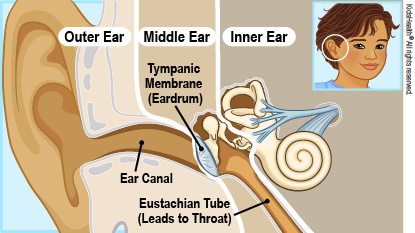Eustachian Tube Problems (Dysfunction): Caring for Your Child
Eustachian tube problems are when the eustachian tube has trouble opening and/or closing. The eustachian (yoo-STAY-shun) tube connects the middle ear (the part of the ear behind the eardrum) to the back of the throat.
Eustachian tube problems (also called eustachian tube dysfunction) can cause pain, pressure, or a feeling of fullness in the ear. They also can make your child feel dizzy; hear ringing or buzzing; or not hear as well as usual.


-
Give your child any prescribed medicines as directed by the doctor.
-
Your health care provider may recommend acetaminophen (such as Tylenol® or a store brand) OR ibuprofen (such as Advil®, Motrin®, or a store brand) for pain. Follow the directions that come with the medicine for how much to give and how often to give it.
-
Yawning, swallowing, or gently blowing the nose may help if your child's ears feel full or blocked. Chewing gum may work well for children older than 4 years old who know not to swallow gum.
-
Talk to your doctor before your child flies on an airplane or goes scuba diving.
-
Keep your home and car smoke-free. If anyone in the home smokes, call 1-800-QUIT-NOW for advice on quitting.

-
Your child has new or worsening ear pain.
-
Your child has pus or blood draining from the ear.
-
You are worried about your child's hearing.

What does the eustachian tube do? The eustachian tube connects the middle ear to the back of the throat. It opens to let air in when we swallow or yawn. This keeps the pressure at the right level in the middle ear. It lets mucus drain from the middle ear into the back of the throat, and prevents nasal and oral secretions from backing up into the middle ear.
What causes eustachian tube problems? Eustachian tube problems can be caused by infections, allergies, sudden changes in air pressure (as when flying or scuba diving), an injury, or breathing in tobacco smoke or pollution. Eustachian tube problems can happen when mucus from the nose or acid from the stomach flows into the eustachian tube and causes inflammation (irritation and swelling). Problems in the way the ears are formed also can cause eustachian tube problems.
Children's eustachian tubes are more easily blocked because the tubes are small and do not slope downward. Children also tend to have larger adenoids, which can block the eustachian tube. Eustachian tube problems often get better as children grow.
How do doctors treat eustachian tube problems? Treatment depends on what causes the problems. Sometimes no treatment is needed and the condition goes away on its own. Other times, the doctor may prescribe medicine. Depending on your child's symptoms, the doctor may also recommend allergy testing. Rarely, a child may need ear tube surgery. Tiny tubes are placed in the eardrum to keep the pressure at the right level in the middle ear and let the fluid drain out.